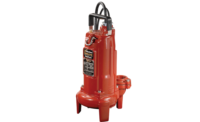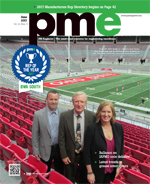Recently, pme interviewed Randy Waldron, vice president of sales and marketing at Liberty Pumps, about issues facing the plumbing industry. Waldron began his career with Liberty Pumps in Bergen, N.Y., in 1982 with a job in the machine shop. Although he took the job as an as an interim position, he stayed with Liberty Pumps and went on to earn a degree in marketing from the Rochester Institute of Technology. He con-tinued to work his way into several different positions throughout the company. Waldron became the national sales manager in 1990 and in 2008 he was named the vice president of sales and marketing.
pme: What innovations in pump technology excite you the most?
RW: The whole grinder technology in pumps has taken a big leap forward in the industry in general over the past few years. Traditionally, sewage pumps have been solids handling. They pass the waste and the solids through in whole form. Grinders actually do what the word says; they grind and chop everything into a fine slurry. Eight years ago, we introduced our V-Slice cutter technology, which we’ve patented. It’s been extremely popular, and the cutter technology has advanced. It does a much better job of cutting. Grinder technology has been a big growth area for our company, and many of our competitors have brought grinder pumps to the market. The reason that grinders are becoming more popular is that more difficult material is entering the sewer system or being flushed down the toilet. Baby wipes and floor cleaning pads can get flushed down the toilet and can easily jam a traditional solids-handling sewage pump. A grinder pump, on the other hand, grinds all that stuff up into a slurry and pumps it through without jamming.
pme: What can plumbing engineers expect to see from Liberty Pumps in the second half of 2013?
RW: Staying with grinders, Liberty recently released our ProVore, which is a residential grinder pump. It’s an exciting product because grind-ers typically have been larger horsepower products that require higher electrical circuits and expensive control panels, which an electrician usually has to install for commercial applications. The ProVore has a 1-hp motor and it simply can be plugged into a standard 115-volt, 20-amp circuit. It doesn’t require an electrician or a fancy control panel. It brings grinder technology down to a more affordable level. It’s also designed to replace a standard sewage-ejector pump. It’s an exciting product for us. We just launched it, and it’s already exceeding our expectations for unit orders.
pme: Are you seeing an increased use of building information modeling and, if so, do you expect this trend to continue?
RW: Some of the larger contractors are using BIM. But I think building designers and specifying engineers tend to use the product more. Lib-erty recently added more than 400 BIM models of our products that are now available in the Revit software library and on our website (www.LibertyPumps.com). An engineer or contractor can go into the library and download a Liberty product. It should be very helpful for them.
pme: Why should engineers consider energy efficiency when specifying sump, sewage or effluent pumps?
RW: Energy efficiency is important in regards to pumps. Depending on the motor design being used, a sump pump could be up to 40% less energy efficient to operate. Liberty uses a PSC [permanent split capacitor] motor on several of our models. These motors provide higher starting torque, which is important, but once the pump is in its run cycle it draws a lot less energy. So, that 40% less energy usage could add up with heavy pump cycling.
pme: What do you see as Liberty Pumps’ most distinguishing feature?
RW: I would say it’s evolving pump technology. In fact, our corporate tag line says, “Innovate. Evolve.” We really live by that. We try very hard in our engineering to develop products that are unique and advance the technology, whether that’s a performance advancement, an efficiency advancement or just making it easier for the contractor to install. We do a very good job at that. A lot of our new products take the technology to a new level. One thing we don’t do is build another pump the same way everyone else has done it, put our name on it, put our color on it and send it to market.
pme: In what new ways is Liberty Pumps connecting with engineers (social media, videos, training, etc.)?
RW: Social media definitely has its place, but Liberty really encourages face-to-face meetings with engineers and contractors. We have two display rigs that travel the country. They’re operated by factory-trained personnel who know the product inside and out. They perform training events all over the country. With the two trailers combined, we do more than 500 events a year. The rigs allow engineers and contractors to have hands-on demonstrations of our products. They can ask questions regarding application and installation. We have the ability to show them the latest and greatest products we have out there.
We have other ways to connect through our website. We just launched an app for the Android; we’re working on the iPhone. The app allows them to download installation and operation manuals, and they can size a pump for the application. They can get pump specifications, perfor-mance curves and all that information readily available to them.
pme: As a company, why does Liberty Pumps place such a big emphasis on fit and healthy employees?
RW: It encourages a good culture. Their better health is better for the company and for everybody. If you’re in better health, you have a better outlook on life, a good attitude and the ability to do your job. There’s just nothing wrong about being in good health. It comes from the owner of the company on down. It’s something we encourage because good health provides a better lifestyle. We emphasize this not so much to benefit the company because all the employees are healthy, but individual people are happier if they’re in good health.
pme: What impact has the unusually wet weather made on your business this year?
RW: Wet weather is good for a company that makes sump pumps. Last year was a drought year, so in comparison this year has been very good. However, this probably is closer to a normal year except in the Midwest where it has been exceptionally wet. The other factor that impacts the sump-pump category is snowpack. Many people don’t understand that a good snowpack will turn into water that will find its way into people’s basements. The snowpack has been good this year in the upper Midwest, and that has helped sales almost as much as the rain has.
pme: If you had one piece of advice to give to plumbing engineers, what would it be?
RW: Specify quality and support U.S. manufacturing. There will always be cheap products available, whether it’s our product category or someone else’s. But a pump sometimes is overlooked as an important piece of equipment for the job it does and the protection it provides. Once it’s installed, it’s almost like it’s “out of sight, out of mind.” But if it fails, a lot of damage can occur. So, specify the best products, support high-quality U.S. manufacturing and protect your reputation.








